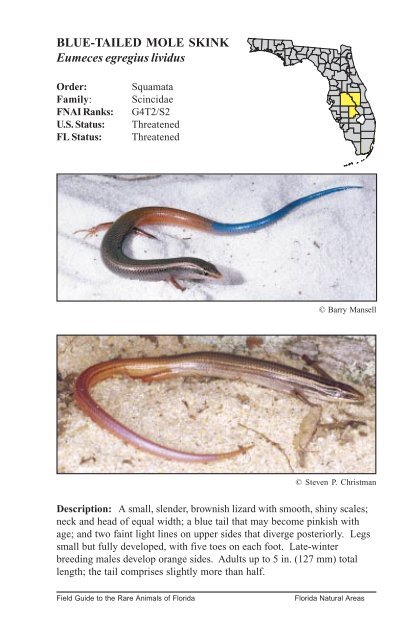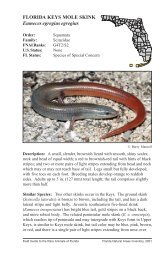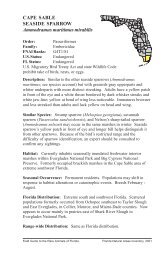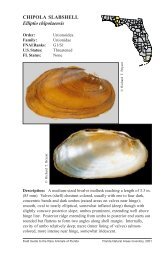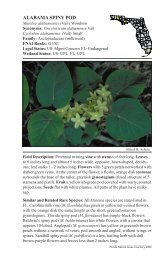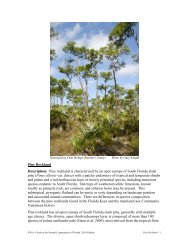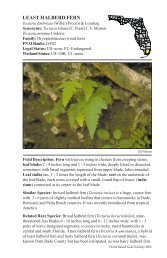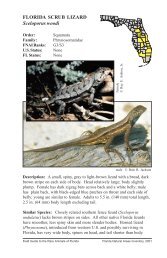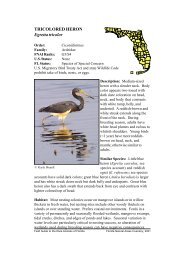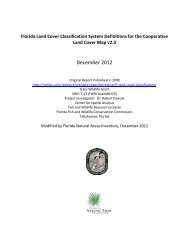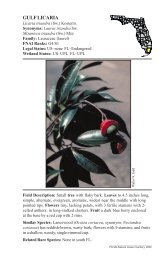BLUE-TAILED MOLE SKINK Eumeces egregius lividus
BLUE-TAILED MOLE SKINK Eumeces egregius lividus
BLUE-TAILED MOLE SKINK Eumeces egregius lividus
You also want an ePaper? Increase the reach of your titles
YUMPU automatically turns print PDFs into web optimized ePapers that Google loves.
<strong>BLUE</strong>-<strong>TAILED</strong> <strong>MOLE</strong> <strong>SKINK</strong><br />
<strong>Eumeces</strong> <strong>egregius</strong> <strong>lividus</strong><br />
Order: Squamata<br />
Family: Scincidae<br />
FNAI Ranks: G4T2/S2<br />
U.S. Status: Threatened<br />
FL Status: Threatened<br />
© Barry Mansell<br />
© Steven P. Christman<br />
Description: A small, slender, brownish lizard with smooth, shiny scales;<br />
neck and head of equal width; a blue tail that may become pinkish with<br />
age; and two faint light lines on upper sides that diverge posteriorly. Legs<br />
small but fully developed, with five toes on each foot. Late-winter<br />
breeding males develop orange sides. Adults up to 5 in. (127 mm) total<br />
length; the tail comprises slightly more than half.<br />
Field Guide to the Rare Animals of Florida Florida Natural Areas
<strong>BLUE</strong>-<strong>TAILED</strong> <strong>MOLE</strong> <strong>SKINK</strong> <strong>Eumeces</strong> <strong>egregius</strong> <strong>lividus</strong><br />
Similar Species: Several other small skinks occur within or near the range<br />
of this subspecies. Older adult blue-tailed mole skinks, and those with<br />
broken or regenerated tails, are indistinguishable from the related<br />
peninsular mole skink (<strong>Eumeces</strong> e. onocrepis), so identification must be<br />
based on locality. The sand skink (Neoseps reynoldsi; see species account)<br />
is very pale, lacks stripes, and has tiny legs with only one or two toes per<br />
foot. The widespread ground skink (Scincella lateralis) is bronze to brown,<br />
with a dark lateral stripe and light belly. Juvenile five-lined, southeastern<br />
five-lined, and broad-headed skinks (E. fasciatus, E. inexpectatus, and E.<br />
laticeps) have bright blue tails, gold stripes on a black back, and more<br />
robust bodies. All salamanders lack scales.<br />
Habitat: Well-drained sandy uplands above 100 ft. (30 m), usually with an<br />
abundance of scattered shrubs and lichens. Favors rosemary, oak, and sand<br />
pine scrubs; occasional in turkey oak barrens, sandhill, and xeric hammock.<br />
Requires loose sand (for burrowing) with patches of sparse to no<br />
groundcover or canopy; often found in leaf litter.<br />
Seasonal Occurrence: Present but difficult to observe year-round.<br />
Florida Distribution: Lake Wales Ridge in Polk, Highlands, and western<br />
Osceola counties.<br />
Range-wide Distribution: Same as Florida distribution. Other subspecies<br />
of E. <strong>egregius</strong> range throughout the state and into southern Georgia and<br />
Alabama.<br />
Conservation Status: Occurs within a series of disjunct state, federal, and<br />
private conservation lands. Most original habitat has been destroyed for<br />
citrus and development.<br />
Protection and Management: Protect all remaining patches of Lake<br />
Wales Ridge scrub. Management may entail infrequent prescribed fire.<br />
References: Ashton and Ashton 1991, Bartlett and Bartlett 1999, Conant<br />
and Collins 1991, Moler (ed.) 1992, U.S. Fish and Wildlife Service 1987.<br />
Field Guide to the Rare Animals of Florida Florida Natural Areas Inventory, 2001


